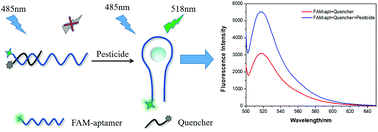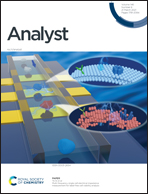The isolation of a DNA aptamer to develop a fluorescent aptasensor for the thiamethoxam pesticide†
Abstract
Aptamers, which are called chemical antibodies for their high affinity and specificity to targets, have great potential as analytical tools to detect pesticides. In this work, a DNA aptamer for thiamethoxam was isolated by an improved SELEX (systematic evolution of ligands by exponential enrichment) strategy, in which the ssDNA library was fixed on streptavidin-agarose beads through a short biotin labeled complementary strand. After 13 rounds of selection, the random ssDNA pool was successfully enriched. Three sequences were chosen as aptamer candidates through sequencing and analysis and were transformed into fluorescent probes to evaluate their interactions with thiamethoxam. A fluorescent turn-on aptasensor for thiamethoxam based on the best aptamer (FAM-Thi13) and a short quenching strand were further designed and showed a quantitative linear range from 10 to 1000 nM with a detection limit of 1.23 nM for thiamethoxam. Molecular docking and molecular dynamics were used to investigate the binding site of the main probe of the aptasensor (FAM-Thi13) and thiamethoxam. Satisfactory results were also obtained in quantifying thiamethoxam in environmental water samples by the developed fluorescent aptasensor.



 Please wait while we load your content...
Please wait while we load your content...